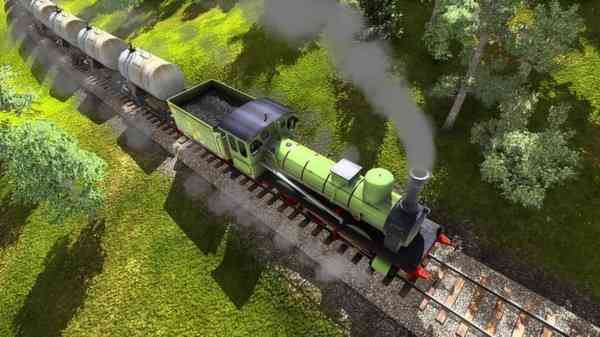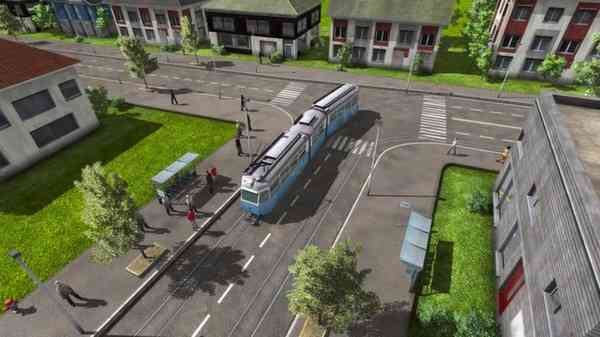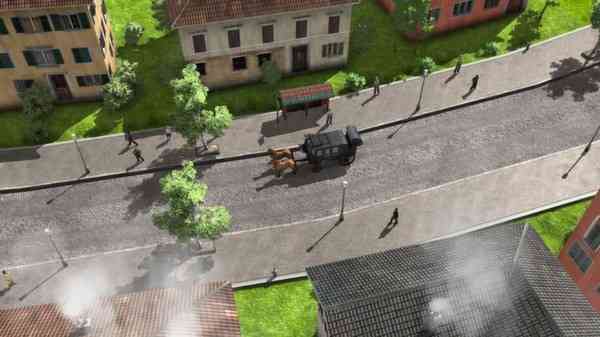It’s not uncommon these days to hear stories of smaller game studios taking to crowdfunding to help fund their dream game. Kickstarter campaigns these days are a dime a dozen. The odd game hits their goal but most never see the light of day. Small developer, Urban Games, took to a different crowdfunding website, Gambitious.com, and led their campaign ending with almost €300,000 by March last year. Several months later the time has come. Train Fever is finally coming out of beta and into full release.
Transport games have come a long ways in the past twenty years. While most will think of SimCity, there were others that focused more solely on the transportation like Railroad Tycoon and Transport Tycoon. I mention these titles because it’s apparent that Train Fever has been influenced by these. While it may draw most of its influence from Transport Tycoon, there’s much more to Train Fever aside from looking modern.
The game is set in 1850 and you are the manager of a transport company, so it’s your duty to build the infrastructure and populate it with railways, busses, stations, and then make all of the appropriate lines to appease your citizens. Being that it’s 1850, don’t expect to see any modern vehicles. Instead you’ll be creating bus and industry lines that carry passengers and cargo by horse and carriage. It’s up to you to create a thriving population and successful transport empire.
Each person in the game has its own AI, home and work address, and they will automatically decide how to get from place to place. When you begin, everyone will be walking places by foot until you start making train and bus lines for people to utilize. Just like people today, people want the fastest and cheapest way to get to their destination, so it’s up to you how to make this happen. When you start to create ways for people to get places, you’ll see those areas grow, even more so when you connect cities together. Do you create multiple train lines that venture from city to city or a complex network of bus routes? It’s up to you.
Train Fever uses its own specialized engine and due to this there are some interesting tricks that it can do. First off, the map can be scaled from small, medium, or large, and is completely randomly generated. The land can be shaped and moulded the way you want, so if you want to run a train line through a mountain you can easily do so by making a tunnel. Cutting across hills and valleys will be costly as you’ll be building bridges or cutting ditches into the land to make your pathway, so terrain contours play a big role in your line creation. Because the game doesn’t use a grid this means that you’re not limited to sharp or intermittent angles, you can create road and railway curves freely, allowing for some unique creations but also very helpful when wanting to avoid cutting a pathway through a mountain.
As you begin your game you’re zoomed out and can see the whole playable map, with small towns being scattered throughout. Surprisingly, you’re able to zoom all the way out to see the whole map, but also zoom in incredibly close to even watch citizens walking around at a street level. Creating roads is simple and a great place to start out learning how to play Train Fever properly. People want to go places and since you’ve not created any bus lines yet, they will be walking from place to place, so you’ll want to remedy that right away. Just like your local city, you’ll want to create a bus depot, station, and bus stops across the city.
Since the game doesn’t have an included tutorial yet, it will take a few games of trial and error to really grasp how to not only place things down, but then how to connect them and properly. First you’ll want to place your bus station and depot somewhere. Then start littering your city with bus stops. Unlike other games, bus stops won’t show a radius of their effectiveness, so it will be trial and error figuring out what works best for your roadways. I simply try and cover the outer edges of the city in a circular fashion and then create your lines and placing purchased buses (remember, it’s 1850, so horse and buggy are the busses) on the appropriate lines. Keep in mind, if you want to spend a little more money, you can also create or upgrade your roads to also have tram tracks on them and make tram lines as well to help your inhabitants.
Being that this is Train Fever, you’ll most likely want to start building some trains for your cities, and the same mechanics are generally the same, but there’s a lot more to factor in when creating your train lines and laying down the tracks if you want them efficient. Firstly, I highly suggest trying to follow landscape contour lines (not on by default by the way) as you’ll quickly find out that tunnels and bridges can easily cost into the millions of dollars to create. You’re much better off making a longer track and going around a large hill as you’ll also learn by trial and error that hills will slow down your trains as you’re able to see train speed limits as you’re placing tracks down (provided the train you purchase can attain those speeds).
Connecting two towns together by train is relatively simple and is much like how you created the bus lines on a smaller scale. First you’ll want to create a station at each city and then simply connect the tracks between them, regardless of the distance. You can simply attach the train depot to the end of the station track if it’s a city near the map edge, but you need to keep thinking ahead, such as wanting to maybe use this station as a hub for passengers to travel to multiple other cities. You can easily add more tracks and attach them as you upgrade, but initial planning will save you a lot of frustration of deleting and relaying track. Just like creating a line for busses, you do the same here by creating a new line, pick your starting point, any in-between, and its end. Purchase a train or more and assign them to specific lines. Voila, you have your first train line!
Once people start utilizing your transport options and as years go by, you’ll most likely see your lines become more and more used, possibly even becoming too busy at times. For busses it’s a simple solution of adding more vehicles to the line, but simply adding more passenger train cars isn’t always going to cut it for your railways. If you purchase too many trains for a train line, it can become cluttered and slower than it was before. This is where you’ll have to start expanding your network of railways, by adding in multiple paths and even passing lanes. The less congested your railways are the faster that can go, which won’t matter much when you begin in the 1850’s, but it will later on when you can purchase newer trains capable of higher speeds.
Just like real train lines, you’re able to place signals along the tracks, and because of the lack of a tutorial, this took me quite some time to really figure out. Basically, you’ll want to place a signal just before any intersection or crossing so that the train knows to take caution if needed. If you place the signal after the danger area, like a passing lane for example, one train could completely stop, blocking the other track and even backup your whole line. Once you get the hang of how to place them properly it will become second nature, but again, it will take a lot of trial and error to learn how to do so.
Now that you’ve got the hang of creating working lines for your passengers, be it by bus, tram, or train, now you get to tackle a completely different side to the transport, the cargo. You can’t simply purchase cargo vehicles and plop them down, they actually need their own stations and lines. If you click the Cargo button in the bottom right of the screen, you’ll see an overlay of what places carry or need what specific cargo and isn’t on by default (just like contour lines). Like cities, industrial plants will be scattered throughout your map, each of which can be a different industry like wood or oil. Clicking on these will give you information and give you an indication of where you’ll want to create lines for your transport to take them.
Keep an eye on your cargo lines and you’ll want to adjust any routes or vehicles accordingly, based on supply and demand, even between cities. You’ll also want to factor in if you should simply create a road to get to the industry plants or if you’ll want a quicker train line to do so. Reading the contour lines should factor into this decision, as creating a railway up a steep hill for one industrial building may not be worth the cost, whereas road vehicles are slower but much less expensive.
The more and more I learned about playing Train Fever, the more I kept learning and figuring out as well. I’m still wrapping my head around some of the smaller nuances, and if you don’t stay organized with your line creations, you’ll easily become overwhelmed. Luckily there are a few features included that make things easier, such as not needing to worry about time tables for your buses or having to micromanage fares and other expenditures. The same goes for laying railway, as it’ll automatically dig into the hills or create ramps where needed to follow the contour lines.
For all the enjoyment I did have with Train Fever though, I did have some major issues during my play sessions. First and foremost, I get incredibly poor performance playing Train Fever. I have a very powerful PC rig that plays the newest MMO’s and other games at maximum settings, yet even at low settings, I had constant issues with Train Fever. I get a constant hitching and in-game lag, but this even starts before I begin a new game in the main menu. I’ve updated all my drivers, tried to troubleshoot and search multiple forums, but nothing has helped. While it wasn’t unplayable, and I have watched other people play via streams and youtube that didn’t have this issue, it was more than frustrating when it’s a constant and no setting changes was able to help remedy it at all.
Be ready for an incredibly long initial load time when the map is being generated. Normally I wouldn’t mention loading times as it is par the course, but it’s absurdly long here. Seriously, I made a sandwich and was already eating it before the map was loaded. This wasn’t due to my rig either, as others have said the same thing. It’s not a deal breaker, but something worth mentioning.
Lastly is the lack of a tutorial. To make matters worse, there is a Tutorial button in the main screen, but it has not been implemented yet. Obviously it is coming and will help, but until then, you’re going to put in a few hours simply to figure out the game before you can start over and enjoy it properly. As mentioned above, it took me quite some time to even figure out how to create lines, and that wasn’t even making them efficient either. There are a lot of smaller mechanics within Train Fever that simply isn’t explained at all. Actually, nothing is. Even when you begin your first game you’re not given any direction or instructions on anything aside from moving the camera, so you just have to start playing around and figuring it out on your own. The learning curve can be steep, so be warned.
All of that being said, once you wrap your head around all of the mechanics and really start to figure everything out, it becomes quite fun to start seeing all of your hard work paying off with passengers finally using your transportation, even if you have hiccups during the learning process. Not having to worry about aligning my roads and tracks to a grid or being restricted to certain angles allowed me to really create lines the way I wanted to. I do wish there was a campaign of sorts, or even goals to strive for, but currently it’s simply a sandbox game.
If you are fan of transport games I definitely recommend giving Train Fever a try. It’s got a great soundtrack that is relaxing and fitting to the genre. When you zoom close up there’s a surprising amount of detail I didn’t really expect from a small development team. Even though you aren’t guided to do anything, you’ll easily be kept busy on an ongoing basis, as there’s always new cargo to obtain, lines to create, and cities to connect. Even with the frustrating technical issues I’ve had with the game, I still find myself wanting to create some more transport lines.




